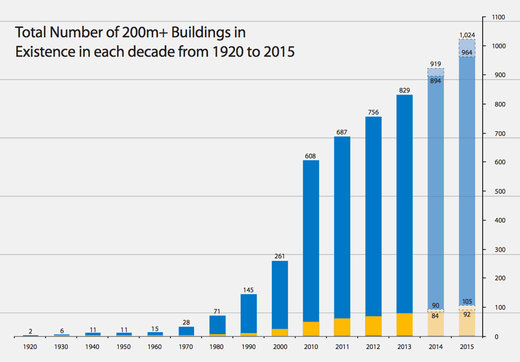4 March 2014
A small increase in the number of tall-building completions around the world last year shows a return to the growth trend of the past decade, a new report finds.
Completions fell slightly in 2012, but the upward nudge of last year has prompted the Council on Tall Buildings and Urban Habitat (CTBUH) to declare 2012 the last year to feel the effects of the 2008-09 global financial crisis.
“A small sigh of relief can be let out in the tall-building industry as we begin 2014,” the CTBUH stated on the release of its 2013 Year in Review report.
The organisation found that 2013 was the second-most successful year ever in terms of 200-metre-plus building completions, with 73 such buildings completed. 2011 is the record-holder to date, with 81 completions.
From 2000 to 2013, the total number of 200-metre-plus buildings increased from 261 to 830 – that’s 318%.
“From this point of view, we can more confidently estimate that the slight slowdown of 2012… was a ‘blip’ and that 2013 was more representative of the general upward trend,” the organisation said.

Source: CTBUH
2013 was the fourth year running to see nine “supertalls” finished – buildings higher than 300m. These 36 comprise nearly half the 77 supertalls now on the planet.
Dubai is still a height hotspot: the tallest building to complete in 2013 was the 355m JW Marriott Marquis Hotel Dubai Tower 2. And for the second year in a row, three of the five tallest buildings completed in a given year were in the United Arab Emirates in 2013.
The United States may have been the birthplace of the skyscraper but it has begun trailing the global pack. Of the 73 built in 2013 only one, 1717 Broadway in New York, was in America.
The city of Goyang, South Korea, debuted on the world skyscraper stage with eight 200m-plus buildings completing in 2013.
Panama added two buildings over 200 meters, bringing the small Central American nation’s count up to 19. It had none in 2008.
China, however, is clearly in the lead. For the sixth year in a row China completed the most 200m+ buildings of any country in the world – 37 last year spread across 22 cities. The tallest building to complete in China in 2013 was the 332m Modern Media Center in Changzhou.
The CTBUH said that concrete remains the building material of choice for tall buildings globally, holding steady at 63% of completions. Composite construction increased from 26% to 32% in 2013, while all-steel construction remained a distant third, at 3% – a long way from 1970 when 90% of the 100 tallest buildings in the world were constructed of steel.

The tallest building to complete in 2013 was the 355m JW Marriott Marquis Hotel Dubai Tower 2
Concrete is the leading material in China, a major concrete producer.
The increasing popularity of mixed-use developments which require a variety of floorplates lies behind the growth of composite construction, the CTBUH concluded.
“A residential or hotel section with compartmentalized apartments might best make use of concrete with its thick cores, smaller spans and sturdy rigidity,” the report said, while “an office section may call for large unobstructed floorplates, which is more easily accomplished in steel.
“As more mixed-use buildings enter the market, it follows that there is an increasing requirement for mixed construction types within a single building.”
The CTBUH predicts that next year will see between 65 and 90 tall buildings completed, although it admits it was “overoptimistic” about the year just past – it predicted 2013 would beat the record set in 2011.
In its 2012 review CTBUH said 66 buildings had been completed that year, but later revised that to 69. The CCTV in Beijing was originally reported complete in 2008 but the CTBUH later determined the interior was finished only in 2012.
Elsewhere, data for the Batumi Technological University Tower in Batumi, Georgia was not submitted until mid-2013, while the original height of Hysan Place in Hong Kong was reported as 190m when it was completed but amended to 204m.










